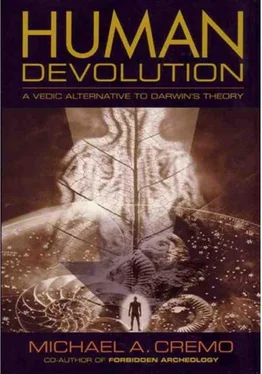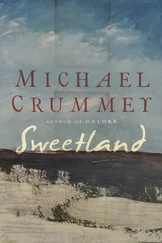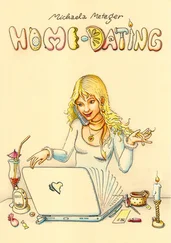Michael Cremo - Human Devolution - A Vedic Alternative To Darwin's Theory
Здесь есть возможность читать онлайн «Michael Cremo - Human Devolution - A Vedic Alternative To Darwin's Theory» весь текст электронной книги совершенно бесплатно (целиком полную версию без сокращений). В некоторых случаях можно слушать аудио, скачать через торрент в формате fb2 и присутствует краткое содержание. Год выпуска: 2003, ISBN: 2003, Издательство: Torchlight Publishing, Жанр: Старинная литература, на английском языке. Описание произведения, (предисловие) а так же отзывы посетителей доступны на портале библиотеки ЛибКат.
- Название:Human Devolution: A Vedic Alternative To Darwin's Theory
- Автор:
- Издательство:Torchlight Publishing
- Жанр:
- Год:2003
- ISBN:9780892133345
- Рейтинг книги:4 / 5. Голосов: 1
-
Избранное:Добавить в избранное
- Отзывы:
-
Ваша оценка:
- 80
- 1
- 2
- 3
- 4
- 5
Human Devolution: A Vedic Alternative To Darwin's Theory: краткое содержание, описание и аннотация
Предлагаем к чтению аннотацию, описание, краткое содержание или предисловие (зависит от того, что написал сам автор книги «Human Devolution: A Vedic Alternative To Darwin's Theory»). Если вы не нашли необходимую информацию о книге — напишите в комментариях, мы постараемся отыскать её.
Human Devolution: A Vedic Alternative To Darwin's Theory — читать онлайн бесплатно полную книгу (весь текст) целиком
Ниже представлен текст книги, разбитый по страницам. Система сохранения места последней прочитанной страницы, позволяет с удобством читать онлайн бесплатно книгу «Human Devolution: A Vedic Alternative To Darwin's Theory», без необходимости каждый раз заново искать на чём Вы остановились. Поставьте закладку, и сможете в любой момент перейти на страницу, на которой закончили чтение.
Интервал:
Закладка:
Possession by Departed Humans
The mediumistic communications we have just examined help establish that personalities of humans who existed on earth are still existing in some other, apparently nearby, dimension of the universe and are capable of interacting with us here through special channels. Frederick Myers, one of the principal researchers in this field, wrote that “the evidence for communication with the spirits of identified deceased persons through the trance-utterances and writings of sensitives apparently controlled by those spirits is established beyond serious attack” (Myers
1903, v. 1, p. 29). Some of the communications gave information of even higher levels or dimensions of the universe, inhabited by higher beings.
We shall now consider another category of evidence that conscious entities exist at some other level of the cosmos—reports of terrestrial humans possessed by departed human personalities. Mediumistic communications also represent a kind of possession, because the medium appears to be temporarily possessed by the communicating spirit. The possession cases that follow are, however, different in that they involve longer and more intense periods of possession. It also seems that the motivation of the possessing spirit to enter a terrestrial human body plays a larger role than in the mediumistic communication cases.
Psychologist William James was willing to consider the reality of spirit possession. The theory that a demonic spirit might take control of a living human body could explain some mental illnesses. In fact, up to the nineteenth century, many physicians in Europe and America did accept this theory. “That the demon theory will have its innings again is to my mind absolutely certain,” said James (Murphy and Ballou 1960, p. 207).
I found the case of the “Watseka Wonder” (Stevens 1887; Myers 1903, v. 1, pp. 361–367) especially interesting because of its detailed documentation of a possession. Watseka, a town of five or six thousand people, is the capital of Iroquois County in the state of Illinois. The Watseka Wonder was a girl named Lurancy Vennum. The daughter of Thomas J. and Lurinda J. Vennum, she was born on April 16, 1864 near Watseka. One night in early July of 1877, Lurancy felt the presence of persons in her room at night. They called her by her nickname, Rancy, and she felt them breathing on her face. The next day, she told her parents about this. On the evening of July 11, 1877, Lurancy was sewing. At six o’clock, her mother asked her to help make dinner. Lurancy said, “Ma, I feel bad: I feel so queer” (Stevens 1887, p. 3). She then fell upon the floor, and lay there, her body quite rigid. After five hours, she regained consciousness but reported she still felt “very strange and queer” (Stevens 1887, p. 3). She then rested for the night.
The next day, her body again became rigid, and during this state she was apparently aware of both her present physical surroundings and another dimension—a world of spirits. Among the spirits she saw a sister and brother who had died and called out, “Oh, mother! can’t you see little Laura and Bertie? They are so beautiful!” (Stevens 1887, p. 3) Lurancy’s visions of spirits and angels continued for several weeks, ending in September. On November 27, 1877, Lurancy suffered severe pains in her stomach, and these attacks continued for two weeks. On December 11, in the middle of these attacks, she entered into a trancelike state and again began speaking of spirits and angels she could see in a place she called heaven (Stevens 1887, p. 4).
On the advice of relatives and friends, Lurancy’s parents considered sending her to an asylum. Asa B. Roff and his wife Ann, on hearing of this, tried to persuade the Vennums not to do it and asked for permission to see Lurancy. Mr. Vennum finally agreed, and on January 31, 1878, Mr. Roff came, along with Dr. E. W. Stevens of Janesville, Wisconsin. Stevens was a medical doctor with spiritualist leanings. When he saw Lurancy, she was sitting on a chair near the stove, having adopted the bodily expressions and voice of an “old hag.” She refused to speak to anyone except Dr. Stevens. She said that only he could understand her, because he was a spiritualist. Stevens asked her name, and she answered without hesitation, “Katrina Hogan.” Further questions revealed the personality of an old woman from Germany, sixty-three years old, controlling Lurancy’s body from the spirit world. After some time, Lurancy’s personality changed. She was now Willie Canning, the delinquent son of a man named Peter Canning. He had run away from home and lost his life (Stevens 1887, pp. 5–6).
When Dr. Stevens and Mr. Roff were getting ready to leave, Lurancy rose up and then fell flat on the floor, her body rigid. Stevens ministered to her, using mesmeric and spiritualist techniques, and soon Lurancy was manifesting her own personality, although she was still in a trance state. She said she was in heaven. Stevens convinced her that she should not allow herself to be controlled by bad spirits such as Katrina and Willie. She should find a nicer spirit. Lurancy agreed and after searching announced she had found one who desired to make use of her. Lurancy said, “Her name is Mary Roff.” Mr. Roff recognized Mary as his daughter, who had died twelve years previously, when Lurancy was one year old. During her life, Mary Roff had displayed clairvoyant and other psychic powers, and these were tested and verified by leading citizens of Watseka. Mr. Roff advised Lurancy that Mary was a good spirit and that she should let Mary communicate through her. Lurancy accepted this suggestion (Stevens 1887, pp. 6–8).
After a few hours, Lurancy came out of her trance. But the next day, February 1, 1878, she claimed to be Mary Roff. Her father then went to Mr. Roff’s office and told him, “She seems like a child real homesick, wanting to see her pa and ma and her brothers” (Stevens 1887, p. 9). But Lurancy did not go immediately to be with the Roffs. She remained at home, continuing to manifest Mary Roff’s personality there. After a few more days, Mrs. Ann B. Roff and her daughter Mrs. Minerva Alter came to see Lurancy. The girl recognized them through a window as they were coming up the street, saying, “There comes my ma and sister Nervie!” (Stevens 1887, p. 13) When the two women entered the house, Lurancy cried for joy, and threw her arms around their necks in greeting, as if she knew them intimately. After this visit, she seemed quite homesick and desirous of going to the Roffs. The Vennums, on the advice of friends, finally allowed their daughter to go, on February 11, 1878.
When Lurancy was being taken by the Roffs to their house, she tried to get them to go to another house on the way. She insisted it was her house. The Roffs had to take her past this house, almost by force. It was the house in which Mary Roff had died. The Roffs had then moved to another house, the one to which they were taking Lurancy (Myers 1903, v. 1, p. 367).
Richard Hodgson, of the American Society for Psychical Research, published a report on Lurancy’s stay with the Roffs, during which “almost every hour of the day some trifling incident of Mary Roff’s life was recalled by Lurancy” (Myers 1903, v. 1, p. 366). Indeed, Lurancy appeared to forget her identity as the daughter of the Vennums. Once, Lurancy told Dr. Stevens about a cut on her arm. As she rolled up her sleeve to show him the scar, she said, “Oh, this is not the arm; that one is in the ground,” meaning that the cut was on the arm of Mary Roff, whose body was now buried. Lurancy (as Mary) recalled seeing her own burial, indicating the soul of Mary Roff had hovered near her body after death or observed the scene from heaven (Griffin 1997, p. 172).
On February 19, 1878, Mr. Roff stated to Dr. Stevens: “Mary is perfectly happy; she recognizes everybody and everything that she knew when in her body twelve or more years ago. She knows nobody nor anything whatever that is known by Lurancy. Mr. Vennum has been to see her, and also her brother Henry, at different times, but she don’t know anything about them. Mrs. Vennum is still unable to come and see her daughter. She has been nothing but Mary since she has been here, and knows nothing but what Mary knew. She has entered the trance once every other day for some days. She is perfectly happy. You don’t know how much comfort we take with the dear angel” (Stevens 1887, p. 17).
Читать дальшеИнтервал:
Закладка:
Похожие книги на «Human Devolution: A Vedic Alternative To Darwin's Theory»
Представляем Вашему вниманию похожие книги на «Human Devolution: A Vedic Alternative To Darwin's Theory» списком для выбора. Мы отобрали схожую по названию и смыслу литературу в надежде предоставить читателям больше вариантов отыскать новые, интересные, ещё непрочитанные произведения.
Обсуждение, отзывы о книге «Human Devolution: A Vedic Alternative To Darwin's Theory» и просто собственные мнения читателей. Оставьте ваши комментарии, напишите, что Вы думаете о произведении, его смысле или главных героях. Укажите что конкретно понравилось, а что нет, и почему Вы так считаете.












